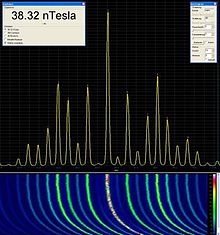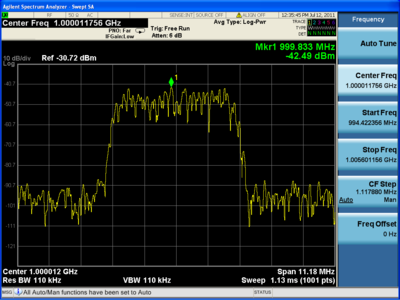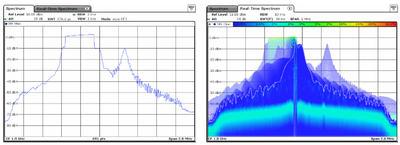- Spectrum analyzer
-
 A spectrum analyzer
A spectrum analyzer
A spectrum analyzer measures the magnitude of an input signal versus frequency within the full frequency range of the instrument. The primary use is to measure the power of the spectrum of known and unknown signals. The input signal a spectrum analyzer measures is electrical, however, spectral compositions of other signals, such as acoustic pressure waves and optical light waves, can be considered through the use of an appropriate transducer.
By analyzing the spectra of electrical signals, dominant frequency, power , distortion , harmonics, bandwidth, and other spectral components of a signal can be observed that are not easily detectable in time domain waveforms. These parameters are useful in the characterization of electronic devices, such as wireless transmitters.
The display of a spectrum analyzer has frequency on the horizontal axis and the amplitude displayed on the vertical axis. To the casual observer, a spectrum analyzer looks like an oscilloscope and, in fact, some lab instruments can function either as an oscilloscope or a spectrum analyzer.
Contents
Types
Spectrum analyzer types are dictated by the methods used to obtain the spectrum of a signal. There are swept-tuned and FFT based spectrum analyzers:
- A swept-tuned spectrum analyzer uses a superheterodyne receiver to down-convert a portion of the input signal spectrum (using a voltage-controlled oscillator and a mixer) to the center frequency of a band-pass filter. With a superheterodyne architecture, the voltage-controlled oscillator is swept through a range of frequencies, enabling the consideration of the full frequency range of the instrument.
- A FFT spectrum analyzer computes the discrete Fourier transform (DFT), a mathematical process that transforms a waveform into the components of its frequency spectrum, of the input signal.
Some spectrum analyzers, such as real-time spectrum analyzers, use a hybrid technique where the incoming signal is first down-converted to a lower frequency using superheterodyne techniques and then analyzed using fast fourier transformation (FFT) techniques.
Form Factor
Spectrum analyzers tend to fall into three form factors: bench top, portable and handheld.
Bench top
This form factor is useful for applications where the spectrum analyzer can be plugged into AC power, which generally means in a lab environment or production/manufacturing area. Bench top spectrum analyzers have historically offered better performance and specifications than the portable or handheld form factor. Bench top spectrum analyzers normally have multiple fans (with associated vents) to dissipate heat produced by the processor. Due to their architecture, bench top spectrum analyzers typically weigh more than 30 pounds (14 kg). Some bench top spectrum analyzers offer optional battery packs, allowing them to be used away from AC power. This type of analyzer is often referred to as a "portable" spectrum analyzer.
Portable
This form factor is useful for any applications where the spectrum analyzer needs to be taken outside to make measurements or simply carried while in use. Attributes that contribute to a useful portable spectrum analyzer include:
- Optional battery-powered operation to allow the user to move freely outside.
- Clearly-viewable display to allow the screen to be read in bright sunlight, darkness or dusty conditions.
- Light weight (usually less than 15 pounds (6.8 kg)).
Handheld
This form factor is useful for any application where the spectrum analyzer needs to be very light and small. Handheld analyzers offer a limited capability relative to larger systems. Attributes that contribute to a useful handheld spectrum analyzer include:
- Very low power consumption.
- Battery-powered operation while in the field to allow the user to move freely outside.
- Very small size
- Light weight (usually less than 2 pounds (0.91 kg)).
Theory of Operation

Swept-Tuned
As discussed above in types, a swept-tuned spectrum analyzer down-converts a portion of the input signal spectrum to the center frequency of a band-pass filter by sweeping the voltage-controlled oscillator through a range of frequencies, enabling the consideration of the full frequency range of the instrument.
The bandwidth of the band-pass filter dictates the resolution bandwidth, which is related to the minimum bandwidth detectable by the instrument. As demonstrated by the animation to the right, the smaller the bandwidth, the more spectral resolution. However, there is a trade-off between how quickly the display can update the full frequency span under consideration and the frequency resolution, which is relevant for distinguishing frequency components that are close together. For a swept-tuned architecture, this relation for sweep time is useful:

Where ST is sweep time in seconds, k is proportionality constant, Span is the frequency range under consideration in Hertz, and RBW is the resolution bandwidth in Hertz.[1] Sweeping too fast, however, causes a drop in displayed amplitude and a shift in the displayed frequency.[2]
Also, notice that the animation contains both up and down converted spectra, which is a due to frequency mixer producing both sum and difference frequencies. The LO feedthrough is due to the imperfect isolation of the LO signal path to the IF signal path in the mixer.
For very weak signals, a pre-amplifier is used, although harmonic and intermodulation distortion may lead to the creation of new frequency components that were not present in the original signal.
FFT Based
With a FFT based spectrum analyzer, the frequency resolution is Δν = 1 / T, the inverse of the time T over which the waveform is measured and Fourier transformed.
With Fourier transform analysis in a digital spectrum analyzer, it is necessary to sample the input signal with a sampling frequency νs that is at least twice the bandwidth of the signal, due to the Nyquist limit.[3] A Fourier transform will then produce a spectrum containing all frequencies from zero to νs / 2. This can place considerable demands on the required analog-to-digital converter and processing power for the Fourier transform, making FFT based spectrum analyzers limited in frequency range.
 Frequency spectrum of the heating up period of a switching power supply (spread spectrum) incl. waterfall diagram over a few minutes.
Frequency spectrum of the heating up period of a switching power supply (spread spectrum) incl. waterfall diagram over a few minutes.
Hybrid Superheterodyne-FFT
Since FFT based analyzers are only capable of considering narrow bands, one technique is to combine swept and FFT analysis for consideration of wide and narrow spans. This technique allows for faster sweep time.
This method is made possible by first down converting the signal, then digitizing the intermediary frequency and using superheterdyne or FFT techniques to acquire the spectrum.
One benefit of digitizing the intermediary frequency is the ability to use digital filters, which have a range of advantages over analog filters such as near perfect shape factors and improved filter settling time. Also, for consideration of narrow spans, the FFT can be used to increase sweep time without distorting the displayed spectrum.
An alternate method, which doesn't use a high local oscillator (LO) (that usually produces a high-frequency signal close to the signal) is used on the latest analyzer generation like Aaronia´s Spectran series. The advantage of this new method is a very low noise floor near the physical thermal noise limit of -174 dBm (1 Hz)[citation needed].
Realtime FFT
Most modern spectrum analyzers are now almost exclusively Hybrid Superheterodyne-FFT based giving a significant improvement in sweep time. However, even in such cases there is still processing time required to sample the spectrum and calculate the FFT. For this reason, both swept-tuned and FFT based analyser produce "blind time" meaning that while calculation of the spectrum is being performed, the instrument has gaps and misses information of the RF spectrum being applied to the RF front end.
A Realtime Spectrum Analyser does not have any such blind time. The analyser is able to sample the incoming RF spectrum in the time domain and convert the information to the frequency domain using the FFT process. FFT's are processed in parallel, gap-less and overlapped so there are no gaps in the calculated RF spectrum and no information is missed.
Online Realtime and Offline realtime
In a sense, any spectrum analyzer that has vector signal analyzer capability is a realtime analyzer. It samples data fast enough to satisfy Nyquist Sampling theorem and stores the data in memory for later processing. This kind of analyser is only realtime for the amount of data / capture time it can store in memory and still produces gaps in the spectrum and results during processing time.
FFT Overlapping
In all spectrum analyzers we want to have information with the least distortion possible. The FFT process applies windowing techniques to improve the output spectrum due to producing less side lobes. The effect of windowing may also reduce the level of a signal where it is captured on the boundary between one FFT and the next. For this reason FFT's in a Realtime spectrum analyzer are overlapped. Overlapping rate is approximately 80%. An analyzer that utilises a 1024 point FFT process will re-use approximately 819 samples from the previous FFT process.[4]
Minimum Signal Detection Time
This is related to the sampling rate of the analyser and the FFT rate. It is also important for the realtime spectrum analyzer to give good level accuracy.
Example: For an analyser with 40 MHz of Realtime bandwidth (the maximum RF span that can be processed in realtime) approximately 50Msample/second (complex) are needed. If the spectrum analyzer produces 250,000 FFT/s an FFT calculation is produced every 4us. For a 1024 point FFT a full spectrum is produced 1024 x (1/50x10^6), approximately every 20us. This also gives us our overlap rate of 80% (20us - 4us)/20us = 80%.
Realtime Display Examples
Persistence
Realtime spectrum analyzers are able to produce much more information for users to examine the frequency spectrum in more detail. A normal swept spectrum analyzer would produce max peak, min peak displays for example but a realtime spectrum analyzer is able to plot all calculated FFT's over a given period of time with the added colour coding which represents how often a signal appears. For example, this image shows the difference between how a spectrum is displayed in a normal swept spectrum view and using a "Persistence" view on a realtime spectrum analyzer.
Hidden Signals
Realtime spectrum analyzers are able to see signals hidden behind other signals. This is possible because no information is missed and the display to the user is the output of FFT calculations. Here is an example of a Bluetooth signal behind a Wireless LAN signal.
Typical functionality
Center Frequency and Span
In a typical spectrum analyzer there are options to set the start, stop, and center frequency. The frequency between the stop and start frequencies on a spectrum analyzer display is known as the center frequency. This is the frequency that is in the middle of the display’s frequency axis. Span specifies the range between the start and stop frequencies. These two parameters allow for adjustment of the display within the frequency range of the instrument to enhance visibility of the spectrum measured.
Resolution Bandwidth
As discussed in the operation section, the resolution bandwidth filter or RBW filter is the bandpass filter in the IF path. Adjusting the bandwidth of this filter allows for the discrimination of signals with closely spaced frequency components, while also changing the measured noise floor. Decreasing the bandwidth of RBW filter decreases the measured noise floor and vice-versa. This is due to higher RBW filters passing more frequency components through to the envelope detector than lower bandwidth RBW filters, therefore a higher RBW causes a higher measured noise floor.
Video bandwidth
The video bandwidth filter or VBW filter is the low-pass filter directly after the envelope detector. This filter is used to “smooth” the display by removing noise from the envelope. Similar to the RBW, the VBW affects the sweep time of the display if the VBW is less than the RBW. If VBW is less than RBW, this relation for sweep time is useful:

Where ST is sweep time in seconds, k is proportionality constant, Span is the frequency range under consideration in Hertz, RBW is the resolution bandwidth in Hertz, and VBW is the video bandwidth in Hertz.[5]
Detector
With the advent of digitally based displays, some modern spectrum analyzers use analog-to-digital converters to sample spectrum amplitude after the VBW filter. Since displays have a discrete number of points, the frequency span measured is also discretized. Detectors are used in an attempt to adequately map the correct signal power to the appropriate frequency point on the display. There are in general three types of detectors: sample, peak, and average
- Sample detection – sample detection simply uses the midpoint of a given interval as the display point value. While this method does represent random noise well, it does not always capture all sinusoidal signals.
- Peak detection – peak detection uses the maximum measured point within a given interval as the display point value. This insures that the maximum sinusoid is measured within the interval; however, smaller sinusoids within the interval may not be measured. Also, peak detection does not give a good representation of random noise.
- Average detection – average detection uses all of the data points within the interval to consider the display point value. This is done by power (rms) averaging, voltage averaging, or log-power averaging.
Displayed average noise level
The Displayed Average Noise Level (DANL) is directly associated with amplitude specifications in a given electronic signal, and the signal's Noise-to-Noise ratio.[citation needed]
RF uses
Spectrum analyzers are widely used to measure the frequency response, noise and distortion characteristics of all kinds of RF circuitry, by comparing the input and output spectra.
In telecommunications, spectrum analyzers are used to determine occupied bandwidth and track interference sources. For example, cell planners use this equipment to determine interference sources in the GSM frequency bands and UMTS frequency bands.
In EMC testing, a spectrum analyzer is used for basic precompliance testing; however, it can not be used for full testing and certification, an EMI Receiver like the Rohde & Schwarz ESU EMI Receiver or Agilent Technologies N9038A MXE EMI is used.
A spectrum analyzer is used to determine whether a wireless transmitter is working according to federally-defined standards for purity of emissions. Output signals at frequencies other than the intended communications frequency appear as vertical lines (pips) on the display. A spectrum analyzer is also used to determine, by direct observation, the bandwidth of a digital or analog signal.
A spectrum analyzer interface is a device that connects to a wireless receiver or a personal computer to allow visual detection and analysis of electromagnetic signals over a defined band of frequencies. This is called panoramic reception and it is used to determine the frequencies of sources of interference to wireless networking equipment, such as Wi-Fi and wireless routers.
See also
- Electrical measurements
- Electromagnetic spectrum
- Measuring receiver
- Spectral leakage
- Spectral music
- Spectrogram
- Spectrometer
References
Footnotes
- ^ Agilent [1], Agilent Spectrum Analysis Basics, pg. 23 , August 2, 2006, accessed July 7, 2011.
- ^ Agilent [2], Agilent Spectrum Analysis Basics, pg. 22, Figure 2-14 , August 2, 2006, accessed July 7, 2011.
- ^ How do I know what is the best sampling rate to use for my measurement?
- ^ Rohde and Schwarz [3], Dr. Florian Ramian - Implementation of Real-Time Spectrum Analysis, pg. 6 , January, 2011, accessed August 9, 2011.
- ^ Agilent [4], Agilent Spectrum Analysis Basics, pg. 36 , August 2, 2006, accessed July 13, 2011.
External links
- Fundamentals of Modern Spectral Analysis
- Swept Spectrum Analyzer Tutorial and Basics
- Sri Welaratna, "30 years of FFT Analyzers", Sound and Vibration (January 1997, 30th anniversary issue). A historical review of hardware spectrum-analyzer devices.
Electrical and electronic measuring equipment Ammeter · Capacitance meter · Distortionmeter · Electric energy meter · LCR meter · Microwave power meter · Multimeter · Network analyzer · Ohmmeter · Oscilloscope · Psophometer · Q meter · Signal analyzer · Signal generator · Spectrum analyzer · Transistor tester · Tube tester · Wattmeter · Vectorscope · Video signal generator · Voltmeter · VU meter
Categories:- Electronic test equipment
- Laboratory equipment
- Measuring instruments
- Radio technology
- Signal processing
- Spectroscopy
- Scattering
Wikimedia Foundation. 2010.




